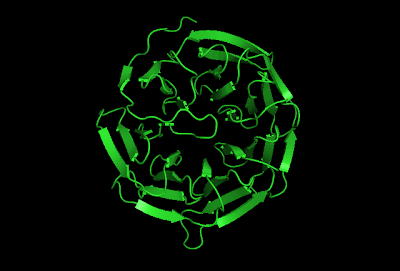- MCC mediated inhibition is not yet fully understood, it most probably involves several mechanisms.
- Mad3 (dependent on its N-terminal KEN box) blocks cdc20 mediated substrate recognition [9]. Mad3’s KEN box binds to the KEN box recognition site of cdc20. This KEN box also stimulates Mad3 dependent APC/C mediated degradation of cdc20 [10-12]; which suggests that Mad3 is involved in targeting cdc20 for ubiquination by the APC/C’s catalytic center.
- The researchers analyzed the MCC crystal structure in the APC/C – MCC complex [13], they concluded that Mad2 contacts with the TPR subunits cdc23 and Apc5, and Mad3 interacts with Apc1. They also found that the KEN box binding site of cdc20 is blocked by Mad3 and the D box faces (but doesn’t touch) its co receptor Apc10.
.jpg) |
| Figure 5a. General overview of MCC bound to APC/C. b. Zoomed in view of interactions of the MCC with the APC/C [2] |
- They compared APC/CMCC to APC/Ccdh1 and they found that cdc20 is displaced downwards towards Apc5 in APC/CMCC ; which could facilitate ubiquination. This also prevents cdc20’s D box binding site from generating a D box co-receptor with Apc10. This plus a temporal steric block of the arginine site of the D-box co-receptor of cdc20 by the Mad3 TPR motif explains the inability of APC/CMCC to recognize and ubiquinate D box dependent substrates [13].
- The structures of cdh1 and cdc20 are very similar:
 |
| Figure 6. A comparative view from above of cdc20 (green) and cdh1 (light blue) |
 |
| Figure 7. A comparative sideways view cdc20 (green) and cdh1 (light blue) |
- In APC/CMCC, part of the cdc20 D box binding site for a Leu anchor and C terminal residues is reachable. Which probably means that a non-consensus D box sequence could use this site.
- Mad2 retaining cdc20’s N-terminal APC/C recognition motifs may well influence the position and activity of cdc20 in APC/CMCC. (The interactions of Mad2 and Mad3 with APC/C also influence this). The Mad2 binding motif of cdc20 mediates APC/C interactions as well, which can be blocked by the Mad2 safety belt. It is thought that Mad2 restraining cdc20’s N terminus may prevent the neighboring C box from reaching its APC/C binding site, which is necessary for cdc20 dependent stimulation of APC/C catalytic activity [14].
- P31comet antagonizes SAC by binding at the Mad2 dimerization interface [15,16]. As Mad3 and p31comet bind to a common Mad2 interface [17], p31comet competes with Mad2 for Mad3 interactions. Which explains how p31comet antagonizes the assembly of the MCC and also induces its disassembly [18,19].
- In conclusion APC/C activity is controlled by blocking substrate recognition and thanks to a series of conformational changes that alter the substrate binding site. Which differs from other complexes such as SCF, in which substrate recognition is regulated via degron phosphorylation.



No comments:
Post a Comment